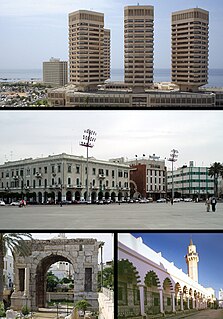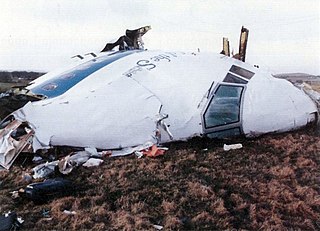
Libya, officially the State of Libya, is a country in the Maghreb region in North Africa, bordered by the Mediterranean Sea to the north, Egypt to the east, Sudan to the southeast, Chad to the south, Niger to the southwest, Algeria to the west, and Tunisia to the northwest. The sovereign state is made of three historical regions: Tripolitania, Fezzan and Cyrenaica. With an area of almost 1.8 million square kilometres (700,000 sq mi), Libya is the fourth largest country in Africa, and is the 16th largest country in the world. Libya has the 10th-largest proven oil reserves of any country in the world. The largest city and capital, Tripoli, is located in western Libya and contains over three million of Libya's seven million people. The second-largest city is Benghazi, which is located in eastern Libya. The Latin name Libya is based on the name of the region west of the Nile (Λιβύη) used by the Ancient Greeks and Romans for all of North Africa, and was again adopted during the period of Italian colonization beginning in 1911.

Tripoli is the capital city and the largest city of Libya, with a population of about three million people in 2019. It is located in the northwest of Libya on the edge of the desert, on a point of rocky land projecting into the Mediterranean Sea and forming a bay. It includes the port of Tripoli and the country's largest commercial and manufacturing center. It is also the site of the University of Tripoli. The vast Bab al-Azizia barracks, which includes the former family estate of Muammar Gaddafi, is also located in the city. Colonel Gaddafi largely ruled the country from his residence in this barracks.

Muammar Muhammad Abu Minyar al-Gaddafi, commonly known as Colonel Gaddafi, was a Libyan revolutionary, politician and political theorist. He governed Libya as Revolutionary Chairman of the Libyan Arab Republic from 1969 to 1977 and then as the "Brotherly Leader" of the Great Socialist People's Libyan Arab Jamahiriya from 1977 to 2011. He was initially ideologically committed to Arab nationalism and Arab socialism but later ruled according to his own Third International Theory.

Cyrenaica is the eastern coastal region of Libya. Also known as Pentapolis in antiquity, it formed part of the Roman province of Crete and Cyrenaica, later divided into Libya Pentapolis and Libya Sicca. During the Islamic period, the area came to be known as Barqa, after the city of Barca.

Benghazi is a city in Libya. Located on the Gulf of Sidra in the Mediterranean, Benghazi is a major seaport and the second-most populous city in the country, as well as the largest city in Cyrenaica, with an estimated population of 632,937 in 2019.

The Libya national football team represents Libya in men's international association football and it is controlled by the Libyan Football Federation. The team has never qualified for FIFA World Cups in history but has qualified for three Africa Cup of Nations: 1982, 2006, and 2012. In 1982, the team was both the host and runner-up. In the Arab Nations Cup, Libya finished second in 1964 and 2012, and third in the 1966. The team is affiliated with both FIFA and Confederation of African Football (CAF).
Saif al-Islam Muammar Gaddafi is a Libyan political figure. He is the second son of the late Libyan leader Muammar Gaddafi and his second wife Safia Farkash. He was a part of his father's inner circle, performing public relations and diplomatic roles on his behalf. He publicly turned down his father's offer of the country's second highest post and held no official government position. According to American State Department officials in Tripoli, during his father's reign, he was the second most widely recognized person in Libya, being at times the "de facto" Prime Minister, and was mentioned as a possible successor, though he rejected this. An arrest warrant was issued for him on 27 June 2011 by the International Criminal Court (ICC) for charges of crimes against humanity against the Libyan people, for killing and persecuting civilians, under Articles 7(1)(a) and 7(1)(h) of the Rome statute. He denied the charges.

Sabha, or Sebha, is an oasis city in southwestern Libya, approximately 640 kilometres (400 mi) south of Tripoli. It was historically the capital of the Fezzan region and the Military Territory of Fezzan-Ghadames and is now capital of the Sabha District. Sabha Air Base, south of the city, is a Libyan Air Force installation that is home to multiple MiG-25 aircraft.

Muammar Gaddafi became the de facto leader of Libya on 1 September 1969 after leading a group of young Libyan military officers against King Idris I in a bloodless coup d'état. After the king had fled the country, the Libyan Revolutionary Command Council (RCC) headed by Gaddafi abolished the monarchy and the old constitution and established the Libyan Arab Republic, with the motto "freedom, socialism and unity".

Pan Am Flight 103 was a regularly scheduled Pan Am transatlantic flight from Frankfurt to Detroit via London and New York City. On 21 December 1988, N739PA, the aircraft operating the transatlantic leg of the route, was destroyed by a bomb, killing all 243 passengers and 16 crew, in what became known as the Lockerbie bombing. Large sections of the aircraft crashed onto a residential street in Lockerbie, Scotland, killing 11 people on the ground. With a total of 270 fatalities, it is the deadliest terrorist attack in the history of the United Kingdom.

The Latin name Libya referred to the region west of the Nile generally corresponding to the Atlantic Mountains according to Diodorus. Its people were ancestors of the modern Libyans. They occupied the area for thousands of years before the beginning of human records in ancient Egypt. Climate changes affected the locations of the settlements.

Italian Libya was a colony of the Kingdom of Italy located in North Africa, in what is now modern Libya, between 1934 and 1943. It was formed from the Italian colonies of Cyrenaica and Tripolitania that were taken by Italy from the Ottoman Empire in the Italo-Turkish War of 1911 to 1912. They were unified in 1934 by governor Italo Balbo, with Tripoli as the capital.

The First Libyan Civil War was an armed conflict in 2011 in the North African country of Libya which was fought between forces which were loyal to Colonel Muammar Gaddafi and foreign supported groups which were seeking to oust his government. It erupted with the Libyan Revolution, also known as the 17 February Revolution. The war was preceded by protests in Zawiya on 8 August 2009 and finally ignited by protests in Benghazi beginning on Tuesday, 15 February 2011, which led to clashes with security forces that fired on the crowd. The protests escalated into a rebellion that spread across the country, with the forces opposing Gaddafi establishing an interim governing body, the National Transitional Council.

The National Transitional Council of Libya, sometimes known as the Transitional National Council, was the de facto government of Libya for a period during and after the Libyan Civil War, in which rebel forces overthrew the Libyan Arab Jamahiriya of Muammar Gaddafi. The NTC governed Libya for a period of ten months after the end of the war, holding elections to a General National Congress on 7 July 2012, and handing power to the newly elected assembly on 8 August.

On 19 March 2011, a multi-state NATO-led coalition began a military intervention in Libya, to implement United Nations Security Council Resolution 1973, in response to events during the Libyan Civil War. The United Nations' intent and voting was to have "an immediate ceasefire in Libya, including an end to the current attacks against civilians, which it said might constitute crimes against humanity ... imposing a ban on all flights in the country's airspace – a no-fly zone – and tightened sanctions on the [Muammar] Gaddafi regime and its supporters."

The 2012 Benghazi attack was a coordinated attack against two United States government facilities in Benghazi, Libya, by members of the Islamic militant group Ansar al-Sharia.

The Second Libyan Civil War is an ongoing multi-sided civil war from 2014 in the North African country of Libya fought between different armed groups, mainly the House of Representatives and the Government of National Accord.

The House of Representatives (HoR) is the unicameral parliament of Libya resulting from the 2014 Libyan parliamentary election, which had an 18% turnout. In late 2014, following the failed coup attempt to take over the capital Tripoli in the context of the Libyan Civil War, the House of Representatives relocated itself to Tobruk in the far east of Libya. As of 2020, it is generally called the Tobruk government. Several HoR sessions were held in Tripoli in May 2019 while Tripoli was under armed attack, electing an Interim Speaker for 45 days.

The Libyan Crisis refers to the current humanitarian crisis and political-military instability that occurs in Libya, beginning with the Arab Spring protests of 2011, which led to a civil war, foreign military intervention, and the ousting and death of Muammar Gaddafi. The civil war's aftermath and proliferation of armed groups led to violence and instability across the country, which erupted into renewed civil war in 2014. The crisis in Libya has resulted in tens of thousands of casualties since the onset of violence in early 2011. During both civil wars, the output of Libya's economically crucial oil industry collapsed to a small fraction of its usual level, with most facilities blockaded or damaged by rival groups, despite having the largest oil reserves of any African country. U.S. President Barack Obama stated on 11 April 2016 that not preparing for a post-Gaddafi Libya was probably the "worst mistake" of his presidency. On October 23, 2020, parties signed a permanent ceasefire.

The Government of National Accord is an interim government for Libya that was formed under the terms of the Libyan Political Agreement, a United Nations–led initiative, signed on 17 December 2015. The agreement was unanimously endorsed by the United Nations Security Council, which welcomed the formation of a Presidency Council for Libya and recognized the Government of National Accord as the sole legitimate executive authority in Libya. On 31 December 2015, Chairman of the Libyan House of Representatives, Aguila Saleh Issa declared his support for the Libyan Political Agreement. During 2015–2017, the General National Congress criticized the unity government on multiple fronts as biased in favor of its rivals, the House of Representatives.

















